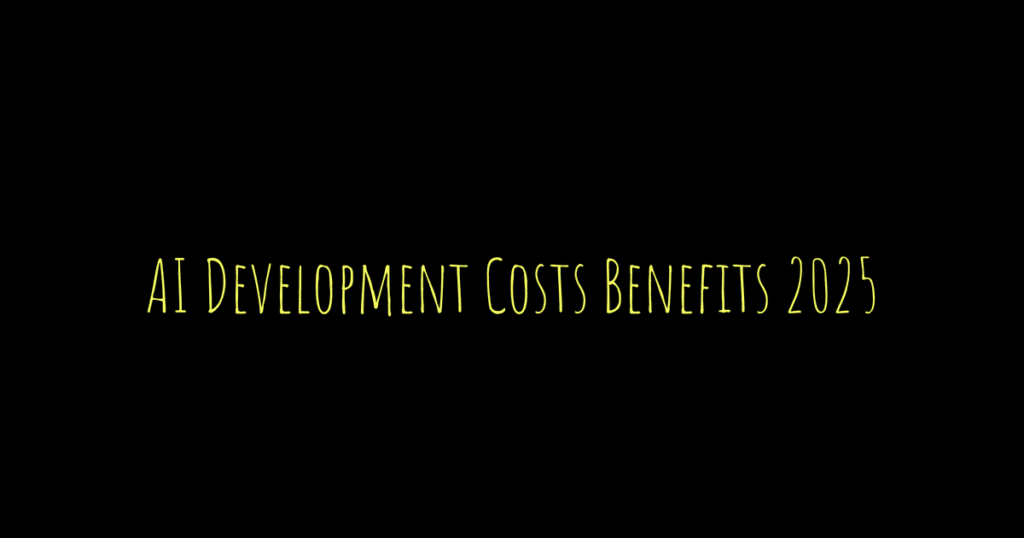Table of Contents
- Overview of AI Development in 2025
- Breakdown of AI Hardware Costs
- Software Expenses in AI Projects
- Labor Costs for AI Talent and Consulting
- Operational Costs: Maintenance and Compliance
- Business Advantages of AI Adoption
- Technological Benefits from AI Innovations
- Societal and Environmental Impact of AI
- Current Trends Affecting AI Costs and Benefits
- Summary of AI Cost and Benefit Estimates
- Frequently Asked Questions
AI development costs in 2025 show a wide range depending on project complexity and industry needs. Hardware expenses, including high-performance GPUs and cloud compute, can stretch from hundreds of thousands to over a million dollars. Software costs vary with licensing, data acquisition, and model training, sometimes requiring significant investments especially for quality datasets and fine-tuning. Labor remains a major part of the budget due to specialized AI talent demanding high salaries. However, these costs bring measurable benefits: improved operational efficiency by up to 40%, revenue increases driven by personalization, faster decision-making, and innovations that support scalability. Balancing cost with these advantages is key for organizations aiming to leverage AI effectively next year.
Overview of AI Development in 2025

In 2025, AI development is marked by widespread adoption across industries, moving beyond pilot phases to full integration into core business processes. Advances in computing power and more sophisticated software tools have made AI more accessible and effective, allowing organizations to embed AI-driven automation and insights deeply into their workflows. Edge AI devices are now common, enabling real-time data processing close to the source, which is crucial for applications like autonomous vehicles and smart manufacturing. Cloud providers have significantly expanded their AI service offerings, lowering the entry barrier for smaller companies that lack large infrastructure investments. While open-source frameworks remain the foundation of AI development, gaining a competitive edge requires skilled customization and tuning, highlighting the ongoing demand for specialized talent. At the same time, as AI models increase in size and complexity, there is a growing need for specialized hardware to handle these workloads efficiently. Integration of AI with IoT and robotics continues to accelerate automation, especially in manufacturing and service industries, improving efficiency and reducing human intervention in repetitive tasks. Development cycles have shortened thanks to better tooling, pre-trained models, and transfer learning, allowing faster deployment and iteration of AI solutions. Alongside this technological growth, AI ethics and governance frameworks are becoming more prominent, ensuring responsible AI use and compliance with emerging regulations. Overall, investment in AI talent and infrastructure remains critical to unlocking AI’s full potential in 2025.
Breakdown of AI Hardware Costs
AI hardware costs remain a major part of overall development expenses in 2025. High-performance GPUs and TPUs form the backbone of AI training infrastructure, with prices often reaching hundreds of thousands to millions of dollars for top-tier setups. For example, training large language models can push cloud compute costs beyond $1 million, while smaller projects may spend under $10,000. Enterprises investing in on-premises AI clusters face significant capital expenditure but gain better control over data privacy and lower latency, which is crucial in sensitive or real-time applications. Edge AI hardware costs are steadily declining, making IoT and embedded AI more accessible, yet the upfront costs for R&D and system integration remain notable. Storage is another essential factor, as AI workloads require vast amounts of data storage; cloud storage prices average around $20 to $25 per terabyte monthly, which adds up quickly for massive datasets. Incorporating specialized AI accelerators and FPGAs can boost flexibility and performance but also increase initial setup costs. Energy consumption during large-scale training runs is a growing operational expense, especially given the shorter hardware refresh cycles driven by rapid advancements in AI technology. To manage costs and performance, many organizations adopt hybrid models combining cloud resources with on-premises hardware. Additionally, leasing and pay-as-you-go procurement strategies help ease capital constraints by spreading out expenses over time.
- High-performance GPUs and TPUs are the backbone of AI training infrastructure, often costing hundreds of thousands to millions of dollars.
- Cloud compute costs vary widely: small projects may spend under $10,000, while large language model training can exceed $1 million.
- On-premises AI clusters require significant capital expenditure but offer control over data and latency.
- Edge AI hardware costs are dropping, but initial R&D and integration require upfront investment.
- Storage solutions must accommodate massive datasets, with cloud storage costing roughly $20-$25 per terabyte monthly.
- Specialized AI accelerators and FPGAs add flexibility but increase initial setup costs.
- Energy consumption of AI hardware is a notable operational expense, especially for large training runs.
- Hardware refresh cycles are shortening due to rapid AI technology evolution.
- Hybrid infrastructure combining cloud and on-premises hardware is increasingly popular to balance cost and performance.
- Hardware procurement strategies often include leasing or pay-as-you-go options to manage capital constraints.
Software Expenses in AI Projects
Software costs in AI projects cover a broad range of expenses beyond just development tools. Open-source frameworks like TensorFlow and PyTorch help lower licensing fees, but they demand highly skilled developers to customize and maintain them effectively. On the other hand, enterprise AI platforms and AutoML tools simplify development but come with steep subscription or licensing fees, often between $50,000 and $500,000 annually. Data acquisition is another major cost driver, varying widely by industry and dataset size; in some cases, purchasing or accessing quality data can exceed $1 million. Manual data labeling remains costly, averaging $1 to $10 per data point, though crowdsourcing and synthetic data generation methods are increasingly used to reduce this burden. Model development expenses hinge on project complexity: fine-tuning existing pre-trained models is generally more cost-effective than training a model from scratch, which requires significant compute resources and expertise. Additional software tooling investments are necessary for version control, experiment tracking, and building deployment pipelines to ensure smooth operations. Licensing fees for pretrained models and API access further add to software expenses, especially when leveraging third-party AI services. Security and compliance tools are essential to protect data and meet regulatory requirements, increasing ongoing operational costs. Integrating AI software with existing enterprise systems often calls for custom development work, which can add complexity and expense. Finally, continuous updates, retraining, and model improvements require dedicated software maintenance budgets to keep AI solutions performing well over time.
Labor Costs for AI Talent and Consulting

Labor costs remain a significant portion of any AI development budget in 2025. Skilled professionals like AI researchers, data scientists, and machine learning engineers typically earn between $100,000 and $250,000 annually in developed markets, with those specializing in fields such as natural language processing, computer vision, or reinforcement learning commanding even higher salaries. Beyond core AI roles, project managers and data engineers are essential for coordinating efforts and managing data pipelines, adding to overall labor expenses. The ongoing shortage of AI talent globally drives up competition and compensation, making recruitment and retention challenging. Employers often invest in training and upskilling existing staff, which increases short-term labor costs but helps improve productivity and reduce turnover over time. Many organizations supplement their teams with contractors or freelancers to gain flexibility, though this can raise management overhead and complicate coordination. Labor costs cover not only salaries and benefits but also time spent on critical activities like data preparation, model development, testing, and deployment. Collaboration between AI specialists and domain experts is often necessary to align models with business needs, sometimes requiring additional consulting fees. External consulting rates range widely from $150 to $400 per hour, and comprehensive project engagements can reach into the millions. Finally, labor costs include recruitment efforts, employee benefits, and retention programs, all vital to maintaining the high-caliber teams needed to deliver successful AI initiatives.
Operational Costs: Maintenance and Compliance
Operational costs play a crucial role in the total expenses of AI projects, often accounting for 15% to 25% of the initial development costs annually. A significant part of this budget goes to continuous model monitoring and retraining to address issues like data drift and model degradation, which can quietly erode performance over time if left unchecked. Dedicated operational teams are essential for managing ongoing system updates, bug fixes, and performance tuning, ensuring AI models run efficiently and scale with demand. Compliance with regulations such as GDPR and new AI-specific laws introduces both legal and technical costs. Organizations must invest in audit trails, transparent reporting, and regular assessments to meet these requirements, which helps build trust but adds complexity and expense. Cybersecurity is another major factor, as protecting AI models and sensitive data from breaches requires robust defenses and constant vigilance, pushing operational costs higher. Infrastructure maintenance is also a continuous expense, including cloud subscription renewals and hardware upkeep, especially when using on-premises resources where energy costs for running AI workloads can be significant. Incident response and disaster recovery planning are often overlooked but critical parts of operational budgets, preparing teams to react swiftly to unexpected failures or attacks. Altogether, these ongoing costs demand careful budgeting and resource allocation to maintain AI system reliability, compliance, and security over the long term.
Business Advantages of AI Adoption
Adopting AI offers clear business advantages that can reshape operations and growth strategies. AI-driven automation alone can cut operational costs by 20% to 40%, especially in manufacturing and logistics, where repetitive tasks are streamlined. For example, predictive maintenance powered by AI reduces unplanned downtime by up to 30%, which translates to significant savings and better asset utilization. AI also boosts revenue through personalized marketing strategies, increasing customer conversion rates by 10% to 25% by delivering tailored offers and recommendations. Beyond cost savings and sales, AI enables companies to develop new products and services, opening fresh revenue streams and market opportunities. Decision-making becomes faster and more informed with AI analytics, improving profitability by 5% to 10% through better risk assessment and resource allocation. Early AI adopters gain a competitive edge by increasing market share through innovation and operational agility. Customer experience benefits as well: AI-powered chatbots and recommendation engines provide 24/7 support and personalized interactions that enhance satisfaction and loyalty. Supply chain optimization driven by AI reduces inventory costs and shortens delivery times, improving overall efficiency. Risk management improves with AI’s ability to detect fraud and anomalies early, protecting assets and reputation. Finally, continuous data-driven insights allow businesses to refine their models and strategies over time, ensuring they stay adaptive and competitive in a rapidly changing market.
Technological Benefits from AI Innovations
AI innovations in 2025 significantly speed up research and development across industries like pharmaceuticals and materials science by automating complex data analysis and predictive modeling. In software development, AI-driven automated code generation and testing cut deployment times by 30% to 50%, enabling faster delivery of reliable applications. AI systems support scalable service delivery, handling millions of users simultaneously while offering personalized experiences tailored to individual needs. Enhanced accuracy in tasks such as image recognition and language translation now surpasses human performance, improving reliability in critical applications. AI models adapt swiftly to new data, ensuring ongoing relevance and effectiveness without the need for complete retraining. Integration with robotics is advancing manufacturing and service automation, reducing errors and boosting productivity. Generative AI tools create novel content types including text, images, and design prototypes, opening new avenues for creativity and innovation. AI-driven simulations assist decision-makers by modeling complex scenarios, improving planning and risk assessment. Transfer learning reduces dependency on large datasets, accelerating model development and lowering costs. Finally, AI-powered accessibility tools are breaking down barriers, enabling broader technology adoption for users with diverse needs.
Societal and Environmental Impact of AI
AI’s influence on society and the environment is becoming increasingly significant by 2025. In healthcare, AI-driven diagnostics and personalized treatment plans are improving patient outcomes by 15% to 20%, offering more accurate and timely care. Education benefits from personalized learning platforms that boost student engagement and retention, helping tailor instruction to individual needs. On the environmental front, AI helps optimize energy use in smart grids and industrial processes, cutting carbon emissions by 10% to 15%, and supports monitoring efforts for conservation and climate change mitigation. Public safety also sees gains through enhanced fraud detection, cybersecurity, and faster disaster response, strengthening community resilience. However, automation brings shifts in labor markets, requiring workers to adapt and acquire new skills for emerging roles. Ethical AI initiatives promote fairness, transparency, and accountability, addressing concerns about bias and misuse. AI-powered accessibility tools improve independence for people with disabilities, while social programs benefit from AI’s ability to analyze large datasets for better policymaking. Finally, global collaboration in AI research encourages knowledge sharing and innovation, helping tackle challenges that cross borders and sectors.
Current Trends Affecting AI Costs and Benefits
Generative AI models are reshaping productivity by automating content creation, coding, and design workflows, but they demand significant compute power and upfront investment, which can drive up costs for many organizations. At the same time, the democratization of AI tools is lowering barriers for small and medium enterprises, enabling wider adoption and bringing new players into the AI landscape without requiring deep technical expertise. However, new regulations around AI ethics, privacy, and transparency are increasing compliance costs, though these measures help build user trust and ultimately support broader acceptance of AI solutions. Hybrid cloud and on-premises infrastructure models are becoming popular as they allow companies to optimize expenses while maintaining data privacy, balancing the scalability of cloud with the security of local hardware. The shift toward data-centric AI means more resources are being allocated to improving data quality, which often yields better results than simply increasing model complexity, impacting budgets related to data acquisition and labeling. Automated machine learning (AutoML) tools are reducing development time by simplifying model building, but the licensing fees for these platforms add a new layer of expense. As AI interpretability and explainability gain importance, development practices are evolving to include transparency features, which can increase complexity and development effort but improve stakeholder confidence. Collaboration platforms that enable distributed AI development across organizations are fostering innovation and resource sharing, which can reduce costs and speed up projects. Sustainability concerns are pushing the design of more energy-efficient AI hardware and algorithms, helping to lower operational costs and environmental impact over time. Lastly, cross-industry AI applications are expanding rapidly, creating diverse use cases and benefits that extend beyond traditional tech sectors, increasing the overall value proposition of AI investments.
Summary of AI Cost and Benefit Estimates
AI development costs in 2025 vary widely based on project scale and technology choices. Hardware investments typically range from $100,000 to over $2 million, driven by needs for high-performance compute clusters or edge devices. Software expenses, including platforms and data management tools, generally fall between $50,000 and $500,000 annually. Labor costs, factoring in skilled AI researchers, engineers, and consultants, often lie between $200,000 and $1 million, reflecting the premium on talent. Operational expenses account for 15% to 25% of development costs annually, covering ongoing maintenance, model monitoring, and compliance with evolving regulations. On the benefit side, AI adoption often leads to efficiency gains of 20% to 40% by automating routine tasks and improving processes. Revenue growth from AI-driven innovations typically ranges from 5% to 25%, through personalized services, new product offerings, and enhanced decision-making. Beyond direct business impacts, AI accelerates innovation by shortening R&D cycles and improving product quality, while also delivering broader societal gains such as better healthcare diagnostics, sustainability improvements, and enhanced education. The overall return on investment depends on a strategic balance of spending on talent, infrastructure, and governance. Continuous ROI tracking and adaptability to changing technology and market conditions remain essential to justify and scale AI initiatives effectively.
| Category | Cost Range (USD) | Key Benefits |
|---|---|---|
| Hardware | $100,000 – $2,000,000+ | High-performance compute for training & inference |
| Software | $50,000 – $500,000+ | Access to frameworks, data, and tools |
| Labor | $200,000 – $1,000,000+ | Talent for development, deployment, & maintenance |
| Operational | 15%-25% of dev costs annually | Ongoing model updates, compliance, and security |
| Benefits | Efficiency gains (20%-40%), revenue impact (5%-25%), innovation acceleration, societal impact |
Frequently Asked Questions
1. What are the main factors that influence AI development costs in 2025?
The main factors include the complexity of the AI model, data requirements, hardware and software needs, talent availability, and the level of customization needed for specific business applications.
2. How can companies measure the long-term benefits of investing in AI development?
Companies can assess improvements in efficiency, cost savings over time, enhanced decision-making capabilities, customer satisfaction, and the ability to innovate faster compared to competitors.
3. What role does data quality play in the overall cost and success of AI projects?
Data quality is crucial because poor data can increase development time, require more cleaning and processing, and reduce AI accuracy, leading to higher costs and less effective outcomes.
4. In what ways can AI development impact a company’s operations beyond direct financial returns?
AI development can improve operational workflows, enable better risk management, foster innovation, enhance employee productivity by automating routine tasks, and support more informed strategic planning.
5. How do emerging AI tools and platforms in 2025 affect development timelines and resource needs?
Emerging tools and platforms often streamline the development process by providing pre-built components, simplifying integration, and improving efficiency, which can reduce timelines and lower the demand for specialized resources.
TL;DR AI development in 2025 involves significant costs across hardware, software, labor, and operations, with expenses ranging from hundreds of thousands to millions of dollars depending on project scale. Businesses benefit through increased efficiency, revenue growth, and faster innovation, while advancements in healthcare, sustainability, and education highlight broader societal impacts. Trends like generative AI, regulation, and hybrid infrastructure shape costs and adoption. To succeed, organizations should invest in talent, focus on data quality, leverage cloud solutions, enforce strong governance, and continuously measure ROI.



